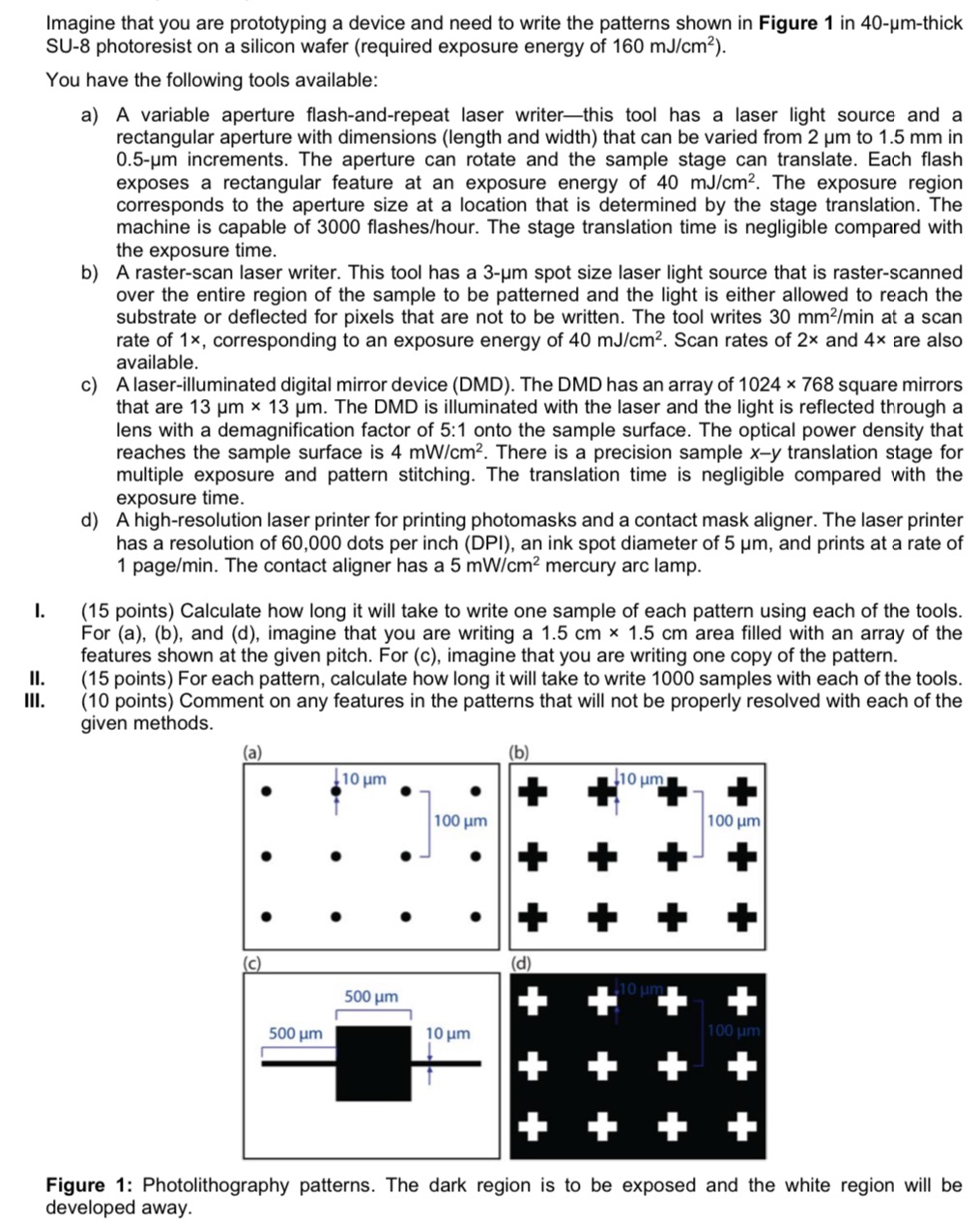Answered step by step
Verified Expert Solution
Question
1 Approved Answer
Imagine that you are prototyping a device and need to write the patterns shown in Figure 1 in 40-um-thick SU-8 photoresist on a silicon

Imagine that you are prototyping a device and need to write the patterns shown in Figure 1 in 40-um-thick SU-8 photoresist on a silicon wafer (required exposure energy of 160 mJ/cm). You have the following tools available: I. II. III. a) A variable aperture flash-and-repeat laser writer-this tool has a laser light source and a rectangular aperture with dimensions (length and width) that can be varied from 2 m to 1.5 mm in 0.5-m increments. The aperture can rotate and the sample stage can translate. Each flash exposes a rectangular feature at an exposure energy of 40 mJ/cm. The exposure region corresponds to the aperture size at a location that is determined by the stage translation. The machine is capable of 3000 flashes/hour. The stage translation time is negligible compared with the exposure time. b) A raster-scan laser writer. This tool has a 3-m spot size laser light source that is raster-scanned over the entire region of the sample to be patterned and the light is either allowed to reach the substrate or deflected for pixels that are not to be written. The tool writes 30 mm/min at a scan rate of 1x, corresponding to an exposure energy of 40 mJ/cm. Scan rates of 2 and 4 are also available. c) A laser-illuminated digital mirror device (DMD). The DMD has an array of 1024 768 square mirrors that are 13 m x 13 m. The DMD is illuminated with the laser and the light is reflected through a lens with a demagnification factor of 5:1 onto the sample surface. The optical power density that reaches the sample surface is 4 mW/cm. There is a precision sample x-y translation stage for multiple exposure and pattern stitching. The translation time is negligible compared with the exposure time. d) A high-resolution laser printer for printing photomasks and a contact mask aligner. The laser printer has a resolution of 60,000 dots per inch (DPI), an ink spot diameter of 5 m, and prints at a rate of 1 page/min. The contact aligner has a 5 mW/cm mercury arc lamp. (15 points) Calculate how long it will take to write one sample of each pattern using each of the tools. For (a), (b), and (d), imagine that you are writing a 1.5 cm x 1.5 cm area filled with an array of the features shown at the given pitch. For (c), imagine that you are writing one copy of the pattern. (15 points) For each pattern, calculate how long it will take to write 1000 samples with each of the tools. (10 points) Comment on any features in the patterns that will not be properly resolved with each of the given methods. (a) (c) 500 m 10 m 500 m 100 m 10 m (b) (d) 10 m 10 m 100 m 100 m Figure 1: Photolithography patterns. The dark region is to be exposed and the white region will be developed away.
Step by Step Solution
There are 3 Steps involved in it
Step: 1

Get Instant Access to Expert-Tailored Solutions
See step-by-step solutions with expert insights and AI powered tools for academic success
Step: 2

Step: 3

Ace Your Homework with AI
Get the answers you need in no time with our AI-driven, step-by-step assistance
Get Started


